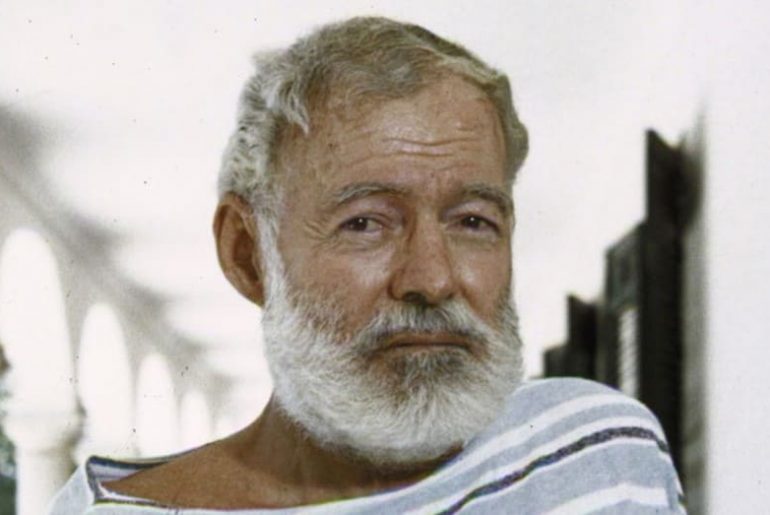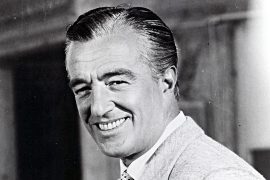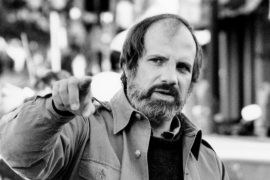Ernest Hemingway was more than a writer. Today one would say: He was a pop star. He understood playing with the media and knew how to stage himself – as a macho, daredevil, globetrotter and cosmopolitan.
Speaking French, Italian and Spanish, Ernest Hemingway has lived in the Italian Alps, in Toronto, Canada, Paris, Key West and in Havana, Cuba’s capital. He has taken part in safaris in Kenya and Tanzania, served as a medic in World War I and covered the Spanish Civil War and World War II as a reporter, taking up arms on more than one occasion, or so the legend goes.
He was an avid boxer, big game hunter and spear fisherman. As “America’s Number 1 He-Man”, a men’s magazine heaved him onto the title in the 1950s.
Suffering from the image
Hemingway fueled this image and at the same time suffered from it. “How can we be ourselves when it’s you in these reviews,” Catherine Bourne asks her husband David in Hemingway’s posthumous novel The Garden of Eden.
This David Bourne bears strong autobiographical traits of Hemingway, like most of Hemingway’s protagonists. His new heroes are broken, uprooted, disillusioned. He is a pioneer, continuing the great American narrative of conquering unknown territory, in a new style: direct, emotionless and surgically precise.
On July 2, 1961, Hemingway killed himself with a bullet like his father had done 33 years earlier. A man like Ernest Hemingway falls in battle, he perishes in a daring adventure. Maybe he’s setting a ball, somewhere far away, in a mythical place, but not in Ketchum, Idaho.
Between classic and modern
Hemingway biographer Wolfgang Stock characterizes him as “the opposite of the poet in the ivory tower. He could observe like a knife and write it down like a surgeon. Hemingway is characterized by a very simple style: subject, predicate, object. Looking back, it’s a modern classic. At the time he was a revolutionary.”
The literary scholar and Hemingway expert Carl Eby describes his style as follows:
“The newspapers of 1924-26 were full of commentary on Hemingway’s new style. People loved his clarity and directness. His style grabbed her immediately. Of course, Hemingway didn’t create this style out of thin air. If you look closely, you’ll find elements from 19th-century American writers like Stephen Crane and Mark Twain, from French romantics like Maupassant and Flaubert, and from Russian classics like Turgenev, Dostoyevsky, and Tolstoy. Hemingway copied a lot from them, but also from modernists like James Joyce and Sherwood Anderson. He studied their style, analyzed it and then took what he liked and put it in a blender, if you will. The result is his own, unmistakable style.”
An American antihero
In 1929, the Roaring Twenties were already history. An epoch characterized by post-war bitterness and oblivion, but also by economic crises, social unrest and political instability. On October 25, Black Friday, the New York Stock Exchange collapses. The global economic crisis began with the crash and was to last well into the 1930s.
In this period of upheaval, In Another Land appears, establishing a new hero: broken, uprooted, disillusioned. He is not a typical American hero like the cowboy or the detective who order the chaos, at least in literature and film, restore justice and reconcile society.
He’s more of an antihero, but an American one: lonely, sincere, capable of suffering.
Hemingway – the legend
Anglist Carl Eby sees Hemingway as a legend. This “didn’t completely match who he was. But it corresponded to one half of his personality: his machismo. For Hemingway himself, this was ambivalent from the start. In the late 1920s, he asked his publisher to stop sending him press articles. He wrote: ‘I can’t read this, it’s on my mind and changing the way I see myself.'”
At the same time, he fuels this image: he writes short stories about the war experiences of his alter ego Nick Adams and his return to an America that he no longer understands. He poses with man-sized spearfish he caught in the Caribbean, with antelope and lion, trophies from his safaris in Africa.
In the Great Depression, millions of small investors lost their savings and millions of farmers lost their livelihoods. For this insecure America, Ernest Hemingway is the ideal projection surface: a man of action, polyglot, virile and adventurous. A pioneer continuing the great American narrative of conquering uncharted territory.
A myth falls apart
“In Another Land” is filmed, the first of eleven works by Hemingway. In the 1930s, Ernest Hemingway was at the height of his popularity. But writing is becoming increasingly difficult for him. His fear of no longer being able to write grows.
Together with Martha Gellhorn, who became his third wife a year later, Hemingway moved to Havana in April 1939, first to the Hotel Ambos Mundos, then to the Finca La Vigía.
In Havana he finishes For Whom the Bell Tolls. The book was published in the autumn of 1940 and within two and a half years, with a sold circulation of almost one million, became the most successful American novel since the southern tart “Gone with the Wind”. This also has to do with World War II, which had started a year earlier with the German invasion of Poland and which the US was to enter in December 1941.
The success of the novel got Hollywood on the scene: Paramount, one of the big studios, secured the film rights for $150,000 – a record sum at the time.
When Ernest Hemingway receives the Nobel Prize, he is 55 years old and a physical wreck: a heavy drinker, overweight, with absurdly high blood pressure, chronically depressed, scarred by numerous accidents suffered on his adventure travels, including a safari in Tanzania, where he narrowly escaped his life in two plane crashes.
Hemingway’s late literary work
It’s been a long time since he published “Wem die Zeit toll” in the early 1940s. Then came “Over the river and into the woods”, more of a short story that was too long and full of excessive monologues – anything but a great hit.
Then, in 1952, came The Old Man and the Sea, a novel about a Cuban fisherman named Santiago and a giant marlin, a spearfish, which he kills using all his remaining strength. It is Hemingway’s last publication until his suicide in 1961.
But he continues to write, every day – like the fisherman Santiago “drives out” every day anew.
A new, posthumous image of Hemingway
The Garden of Eden was published posthumously in the 1980s. The book is about sexual experiments, playing with gender roles and culminates in a love triangle.
“When it came out, it surprised everyone: the literary critics, the public, the fans. Everyone had a certain image of Hemingway. He was considered a typical hypermasculine idol. This book turned that picture on its head,” says Verna Kale of this book.
Traces of androgyny
According to Carl Eby, after the publication of The Garden of Eden, literary scholars began to revisit his older works, noting that “he had always been fascinated by androgyny. In many of his novels there are lovers who look like brother and sister and have their hair cut identically. María in ‘For Whom the Bell Tolls’ has short hair, as does Brett Ashley in ‘Fiesta’. Katherine from ‘In Another Country’ has her cut short at the end of the novel, which turns Frederic on quite a bit. They talk about wanting to look the same and getting the same haircut. People have long overlooked this or ignored it. But once you know The Garden of Eden, you can’t ignore it. The whole novel is about that.
This fascination dates back to Hemingway’s childhood. His mother actually wanted twins, which she didn’t get. But she raised him as his sister’s twin, who was a year and a half older. Sometimes she dressed them both as girls, sometimes as boys, each down to the identical haircut. I don’t want to say that clothes make the later man. But his mother sometimes saw him as a girl. For example, when he was three and a half he was afraid that Santa would not know if he was a boy or a girl.”
Frederic formulates his philosophy in the novel “In Another Country”: “Life breaks everyone. It kills the brave who refuse to break. Life gets you in the end.”
What was Ernest Hemingway known for?
The influential American literary icon became known for his straightforward prose and use of understatement. Hemingway, who tackled topics such as bullfighting and war in his work, also became famous for his own macho, hard-drinking persona.
When did Hemingway become famous?
The Old Man and the Sea became a book-of-the-month selection, made Hemingway an international celebrity, and won the Pulitzer Prize in May 1953, a month before he left for his second trip to Africa.
What was Ernest Hemingway’s greatest accomplishment?
In 1925, the couple, joining a group of British and American expatriates, took a trip to the festival that would later provide the basis of Hemingway’s first novel, The Sun Also Rises. The novel is widely considered Hemingway’s greatest work, artfully examining the postwar disillusionment of his generation.
What is Ernest Hemingway’s most famous quote?
“The world breaks everyone and afterward many are strong at the broken places.”
What did Ernest Hemingway say about war?
Commenting on this experience years later in Men at War, Hemingway wrote: “When you go to war as a boy you have a great illusion of immortality. Other people get killed; not you. . . . Then when you are badly wounded the first time you lose that illusion and you know it can happen to you.
What does Hemingway say about writing?
1. I learned never to empty the well of my writing, but always to stop when there was still something there in the deep part of the well, and let it refill at night from the springs that fed it. 2. If a writer knows enough about what he is writing about, he may omit things that he knows.
What does Hemingway say about life?
“Every man’s life ends the same way. It is only the details of how he lived and how he died that distinguish one man from another.” “Never confuse movement with action.” “The world breaks every one and afterward many are strong at the broken places.”
Was Hemingway really good?
I think the reason Hemingway is considered to be one of the best writers of the 20th century is because he revolutionized brevity in the english language. His style of writing, with short, concise sentences help not only to get the story across easier, but show that more doesn’t always mean better.
Why is Hemingway’s writing so good?
Hemingway’s strength lies in his short sentences and very specific details. His short sentences are powerfully loaded with the tension, which he sees in life. Where he does not use a simple and short sentence, he connects the various parts of the sentence in a straightforward and sequential way, often linked by “and”.
What habits did Ernest Hemingway have that kept him from procrastinating?
By stopping at a high point – an interesting place in a story – Hemingway probably felt good about most of his sessions (end was great), avoiding stopping utterly exhausted and miserable, which would make the memory of a session much gloomier (end being bad).
How many hours a day did Hemingway write?
One of our favorite writers, Haruki Murakami, got up at 4:00am every day and wrote for 5 to 6 hours. Ernest Hemingway wrote for 5 or 6 hours every morning as did Kurt Vonnegut.
Did Hemingway write every day?
Ernest Hemingway: “I write every morning.”
When I am working on a book or a story I write every morning as soon after first light as possible. There is no one to disturb you and it is cool or cold and you come to your work and warm as you write.
What kind of typewriter did Ernest Hemingway use?
The first generation of Royal Quiet Deluxe was manufactured from 1939 until 1948, with a gap in production due to World War II. It was the typewriter of choice for Ernest Hemingway.
How did ernest hemingway die?
Ernest Hemingway was found dead of a shotgun wound in the head at his home here today. His wife, Mary, said that he had killed himself accidentally while cleaning the weapon. Hemingway’s obituary ran on the front page of The New York Times on July 3, 1961.
Where was ernest hemingway born?
Oak Park, Illinois, United States
Which sentence in this excerpt from “in another country” by ernest hemingway is an example of irony?
The sentence in the above excerpt from “In Another Country” by Ernest Hemingway which is an example of irony is: “You are a fortunate young man.”
When did ernest hemingway die?
Ernest Hemingway died on July 2, 1961.
What time period did ernest hemingway write in?
Hemingway produced most of his work between the mid-1920s and the mid-1950s, and he was awarded the 1954 Nobel Prize in Literature. He published seven novels, six short-story collections, and two nonfiction works.
Is mollie hemingway related to ernest hemingway?
She is the granddaughter of Ernest Hemingway.
What literary movement was ernest hemingway a part of?
Hemingway was also one of the leaders of the modernist literary movement, which took place after World War I. Modernist writers, including Gertrude Stein, William Faulkner, Marianne Moore, John Dos Passos, F.





